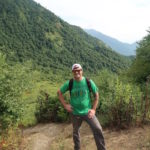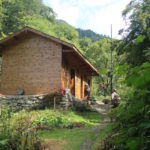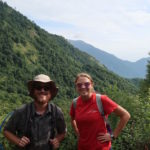With a cool breeze hitting our faces early in the morning, the CCRCGP delegate pointed towards a break between the mountains about 1000 vertical feet up. The extra body weight that I decided to put on was yelling at me to turn around, but the opportunity to see and study potential reintroduction pandas kept me climbing. As Zack seemed perfectly as peace with the constant outpouring of sweat, I methodically labored a 30lb. pack full of camera traps to the first locked gate.
After meeting our “gatekeeper”, we had another 1/4 mile to reach the field station. Meng Meng, a worker with the panda base, assured me that it was easy going from there. Up then down, slip then slide, we pulled to the side to catch our breath. When we finally arrived, we were blown away by the extremely well outfitted camp where the reintroduction workers stay. Bunk beds, internet, T.V., desks, kitchen table, and a multitude of other amenities, leave you to believe that they are not ruffing it out here.
- Stop and take it all in
- Tiantiashan field station
- Zack and Nicki
Working out a few details with the field staff, we started towards the first reintroduction pen around 10:30 am. Crossing a creek and immediately into thick brush, switchbacks indicated what we were in store for. Climbing another 400 feet, we reach a point along the security fence where the staff can call in the adult panda to a large cage. Within a few minutes she arrived, looking happy to see us. This was a special moment for Nicki as this was her very first time seeing a panda. We radioed back to the field station to cut the power to the electric fencing and crawled through the sliding gates to begin searching for an appropriate camera location.
Settling on a steep clearing centered around a stream, we placed four cameras around the perimeter, all focused on a log that we coated with panda scent. In order to find the location in the future, we took GPS coordinates and managed to complete the setup in about 40 minutes. Excited to have installed our first set of cameras for the day, we crawled through the leech infested, bamboo forest and back to the entrance point. Turning the electricity back on, we released the female back into the pen and headed down to the field station.
Covered in mud, blood, and sweat, we were beyond tired and a little cold given the high elevation of 8600 ft. We ate lunch with the workers and planned to head to the next pen at 2:00 pm. Just before our teeth started to chatter, we suited back up and began our next hill climb in another pen and to find a good spot for the cameras. As the pens are about 50 acres in size, the perimeter can take several hours to traverse. It’s a marvel to think about the manpower that must have gone into creating such an immense enclosure with heavy duty cyclone fencing, this far into the forest.
Hiking along the fence line, we made it to the very top before deciding to dive right into the thickest brush possible. As our backcountry guide was equipped with a Chinese machete, he led the way, hacking a path that left us high-stepping over jagged bamboo shoots down a 45 degree slope. Covered in mud and looking like we had been living in the back country for the last week, we settled on a well traveled spot that allowed us to fasten all of the cameras to trees or bamboo. With a quick slide down the hill and back to the field station, we rested for 10 minutes before continuing to our hired ride and back to the apartment.
Stepping out of the car, everyone was aching from such a long days work. We all agreed to meet for dinner 45 minutes later. Thinking back to it, it’s hard to appreciate the beauty of the moment when you are out of breath, dripping in sweat, and staring up a hill that you still have to climb. But, as long as you take small breaks and turn around to gaze at the vast bamboo forest that is inhabited by giant pandas, you quickly realize how lucky you are. One day of pain for a lifetime of pleasurable memories.
_______________________________________________________

The entire PDXWildlife family is currently in Sichuan, China. Located at two research locations (Bifengxia & Wolong), we are collecting data on reintroductions, maternal care, stereotypic observations, personalities, and fecal hormones. Give our website a visit or leave a comment below to learn more. www.pdxwildlife.com





All that and leeches too! Quite the adventure, but I imagine the pictures will be invaluable in your research.
I look forward to your further reports!
We head back up on Sunday to see if we were successful with the semi-wild camera traps. Very excited. The internet is something of an oddity here in Gengda, due to the fact that it works really well. With my continued jet-lag keeping me up in the middle of the night, I pass the time sending out updates.
Cheers-
Good to know about the Internet at Gengda. Sorry about the jet lag but loving the updates!
I’ve been trying to figure out a sleep schedule for the plane on the off chance that I will actually be able to sleep, which I rarely can on planes. It all reminds me of those math problems I was so bad at involving a plane traveling at x knots/hr against a wind of y knots/hr and what’s the pilot’s first name if his sister’s cat just had three black kittens and four gray ones. Plus–I work the night shift so my sleep schedule is a little skewed anyway, and apparently sometimes the plane flies east and sometimes west, depending on winds, etc., but it’s really kind of north-south over the pole from here. Maybe I’ll see polar bears.
Say hi to ZZ and also her girls if you see them.
The jet lag issue is a problem that we still have not solved. When we board the plane from Oregon, it’s usually in the morning. We then arrive to our Chengdu hotel ~about 24hrs later. This means that its still morning to our system, but the 15 hr time difference makes it somewhere between 6pm and midnight. It suffices to say that we are backwards.
Everyone is different in how their body handles the time change, but what seems to hold true is that for every 2hrs of time change, your body wants a day to rest and catch up. I find myself waking up at 1 am then 2 the following night, and so on until I get back to a 7 am wake up. So, with 15 hrs. to catch up on, we usually need 7 days. That’s 7 days of feeling like a zombie. The return, as we have also found, is twice as bad. Then again, with some people it doesn’t faze them at all- Super humans. In short, jet lag sucks. I pass the time with movies, food, and a little work.
I looked at Flight Aware, which has a posting from someone who took the same flight I’ll be on (though the post is from 2015–hope the food looks better now) and it said there were basically three meals/snacks, so I guess I’ll do a movie and try to sleep in between meals. I use melatonin at home and will try it on the flight this time. When I went to Australia about 10 years ago, I didn’t sleep at all on the way over and took a long time to acclimate. On the way home, I was in a middle seat on a fully loaded plane, so not much joy there, though I possibly dozed a little bit. Surprisingly enough, I went to work the next day and took much less time to get back on track sleepwise even though I had flown westward. Go figure.
I guess it depends on which airline you are flying with, but I believe that almost all of them now offer the head rest entertainment. I find that they give you enough movies/sitcoms to choose from that you can veg out for the entire flight. I’ve even tried the chemical route and took an Ambien to try and zonk out, but with no success. I’m still waiting for the miracle jet lag cure.
Just remember the rule for the middle seat- Since you get the hardship of getting squeeze between two people, both armrests belong to you.
Flying United. So far, aisle seats reserved–hope there’s no last minute relocation hanky panky!
I meant eastward.